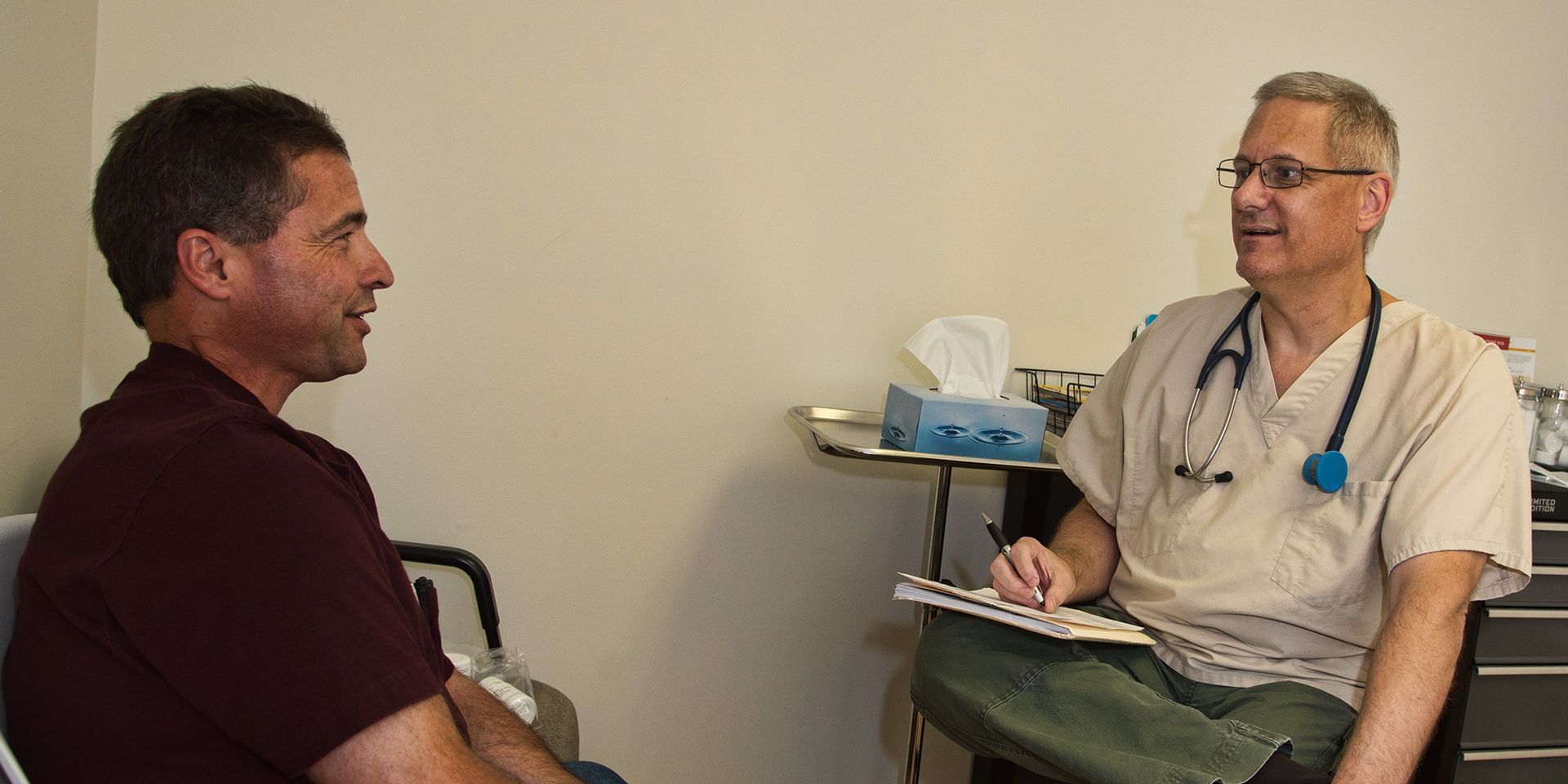Direct Primary Care

In late 2011, I was becoming more and more dissatisfied with practicing medicine. I was being driven by what insurance companies dictated instead of the needs of the patients I was treating, in addition to having to see more patients in a shorter amount of time to maintain the income to which I was accustomed. I began seeing and reading articles about “direct primary care” models and how the doctor-patient relationship could be restored. So, in the spring of 2012, I decided to leave the practice I was part-owner of to start my own direct primary care practice.
What Is Direct Primary Care?
Direct primary care (DPC) is an innovative alternative payment model for primary care that has been spreading across the country for the last 15 years. The primary element of DPC is getting back to the basis of the doctor-patient relationship without insurance or other entities being involved because that relationship is the key to improved health outcomes, improved patient and physician experiences, lower healthcare costs and improved access to care. For a modest monthly fee—about the cost of a gym membership—patients receive personalized medical care including basic lab tests, x-rays and minor procedures. Plus, there are no co-pays or deductibles to keep track of and no permission requirements for ordinary procedures. In addition, patients have fewer trips to the emergency room and specialists when the primary care physician can handle the matter in the office.
DPC achieves this relationship with the patient by focusing on five key tenets:
- Service: The hallmark of DPC is adequate time spent between the patient and physician. The physician is able to spend more time with each patient without hurrying to see the next patient, which allows more frequent and detailed discussions regarding lifestyle choices and treatment decisions aimed at long-term health and wellbeing.
- Patient Choice: Patients can choose their own personal physician and are fully involved in making their own medical and financial choices. Additionally, DPC patients have the right to transparent pricing, access and availability of all services provided.
- Elimination of Fee-For-Service: DPC eliminates the undesired fee-for-service incentives in primary care which distort healthcare decision-making by rewarding volume over value. DPC helps avoid inappropriate testing, referrals and treatment based on brief patient encounters.
- Advocacy: DPC healthcare professionals are committed advocates for patients and assist them in their healthcare decisions.
- Stewardship: DPC healthcare professionals believe healthcare must provide more value to the patient with higher performance, so the ultimate goal is health and wellbeing, not simply treating the disease.
How Does It Function?
In its truest form, a retainer-based alternative payment practice seems to be the most common form of practice. Other forms include numerous variations on the retainer-based model to an “a la carte menu” type practice. While they do have some similarities, most do not consider concierge practices to be DPC practices because of their differences. Both seek to improve the quality of care for the patient along with improvement of physician job satisfaction and pay, but concierge practices tend to have significantly smaller panel sizes than DPC practices. Access to care through the concierge practice is limited due to affordability of the membership fee, whereas DPC practices tend to improve access for low income and uninsured patients by being more affordable to the average person. DPC practices can survive in all types of communities with lower out-of-pocket and downstream costs.
In the retainer-based model, the patient and physician are mutually benefited. The retainer is charged monthly and a small visit cost is collected at the time of the visit. From the patient standpoint, their monthly fee is low enough not to cause difficulty with their family’s livelihood and the office visit cost is minimal. The monthly retainer and small visit cost usually covers in-office care including minor procedures, IV fluids and basic labs. These fees ranged from $45 to $100 per month per adult and $25 to $50 per month per child, with the office visit fee from $20 to $40 per visit.
When I began researching different models of DPC clinics, I didn’t think my local Tri-Cities area in East Tennessee was ready to buy into this current retainerbased model. Instead, I decided to start this new venture with a “pay as you go” model. With this model, the patient pays for the visits at the time of service without a monthly or quarterly membership fee. Our office visit fees are significantly lower than traditional practices and urgent care visits. Our goal at the beginning was to run the practice as lean as possible with very low overhead, so we started with two volunteer staff members: one nurse (my wife) and one receptionist (my mother).
Is It Working?
Based on a review of data regarding DPC practices, the model that seems to be the most successful is the retainer-based practice model. The monthly fee allows physicians to have a guaranteed monthly income without having to worry about how many patients they see each day. This type of model also allows for much lower overhead cost. In most cases, the minimal visit cost basically covers the overhead cost for that visit. Therefore, the physician is able see fewer patients per day with more time to see each patient. Allowing more time to develop the doctor-patient relationship without interruption will lead to better quality of care and improved outcomes. Having adequate time to listen to and care for the patient is the one of the main reasons we went into healthcare in the first place. More time with patients is the biggest contributing factor to why DPC physicians report significantly improved job satisfaction.
However, DPC practices do face some uncertainty due to legal concerns with regard to lack of policy consensus regarding DPC providers. Specifically, the concerns focus on how the state and federal laws and regulations should treat such practices. The first concern is whether DPC providers are acting as “risk bearing entities” when providing care in exchange for a monthly fee, as well as whether or not they should be licensed and regulated as insurers. Currently, the policies and regulations vary from state to state. For example, Utah enacted laws to clarify that DPC practices are explicitly exempt from insurance regulation.
In the Affordable Care Act, the U.S. Department of Health and Human Services (HHS) recognizes that direct primary care medical homes are providers, not insurance companies. However, to qualify under this, the DPC medical home enrollment must be coupled with a wraparound insurance plan (catastrophic insurance) that meets all applicable requirements. Unfortunately, at this point the Secretary of HHS is responsible for setting these requirements, and the secretary has been slow in establishing these criteria. Additionally, under IRS code, health savings accounts (HSAs) cannot be used to cover the monthly fees if the patient is covered under a high deductible health plan that covers primary care benefits. Several members of Congress are currently trying to address this issue by changing the code to allow HSAs to cover DPC fees for patients.
And finally, in order for DPC providers to see Medicare patients, the providers have to opt out of Medicare, otherwise they may violate Medicare’s current balance billing prohibition which forbids physicians from charging in excess of allowable rates. If physicians who are participating in Medicare try to collect a monthly fee for direct primary care for services covered under Medicare, then they are in violation of this law. Therefore, physicians who provide direct primary care to Medicare patients should opt out of Medicare for now. Until Congress eliminates current barriers and restrictions, it will be difficult if not impossible for Medicare participating physicians to see Medicare patients through the DPC model.
Pros vs. Cons
From the patient side of the DPC model, patients are able to benefit from lower out-of-pocket healthcare costs with better quality of care-which leads to better outcomes. In studies conducted by Brian Forrest, MD, he found these premises to be true and reproducible.
Based on NHANES 2007-2010 data, only 50 percent of patients nationally with high blood pressure who are seeing a doctor and are being treated for high blood pressure have their blood pressure under control. On the other hand, patient data from Dr. Forrest’s DPC clinic in North Carolina from 2011-2013 showed 80 percent of patients at goal at a lower cost of care.
During my time practicing my DPC model, I believe my stress level has significantly decreased and my enjoyment of caring for patients has increased. Being able to return to the doctor-patient relationship renewed my reason for becoming a physician. I am able to invest in both patients’ and their families’ lives. Together, we are able to provide care by treating their physical, emotional and spiritual illnesses. In this model of practice, I have the ability to spend time talking with patients without feeling rushed by the need to see more and more patients per day.
In our DPC model, the practice overhead is lower, but it does vary based on services provided by the practice. In my current practice, I provide a full range of services from suturing, casting, lump and bump surgery, vasectomies, colposcopy, cryosurgery, biopsies, etc. As such, my overhead runs approximately 45 percent, which is about 15 percent lower than traditional family practice. Another advantage to DPC practice is less bureaucracy and paperwork.
However, there are some disadvantages too. My income has not been consistent due to fluctuating numbers of visits per day. People will not see us unless they have the cash on hand, so our schedule can be extremely light some days and heavy other days (averaging nine to 15 patients per day). This makes my income significantly less than what I was making in traditional fee-for-service practice. Based on our experience, the model of a monthly retainer or membership fee with a small visit fee provides a higher, more consistent monthly income.
Patient recruitment is also more difficult because of the “co-pay” mindset–they expect to either not pay or pay very little for their healthcare. DPC is a foreign concept for most patients who don’t like to pay for something they don’t receive or use, so the retainer or membership models require some education to the advantages of this style of practice.
The Christian Perspective
From a Christian perspective, DPC opens a great avenue for sharing your faith with your patients and their families as it allows you to spend more time getting to know and interacting with them during the visits. In traditional practices, time constraints can limit your ability to allow deeper discussions about underlying issues influencing the patient’s condition. Recently, a young lady presented to my office with complaints of having frequent palpitations and associated symptoms including anxiousness. She was seen by several other physicians throughout the course of her care with only partial evaluation of the problems due to cost of care. In the DPC setting, she was able to complete her work-up including a holter monitor for less than $200. During the prolonged office visit, we were also able to explore the underlying cause of her anxiety which was the source of her cardiac symptoms. She had been the victim of abuse by a family member when she was a teenager. Only because I was able to spend time with her, listening to her describe her symptoms and developing the doctor-patient relationship, were we able to get to the base of the problem. Now that trust has been established, we can work together toward both emotional and spiritual healing for her.
In the DPC setting, underinsured and uninsured people are able to have access to quality physician-driven healthcare that doesn’t break the bank. By eliminating the middleman in healthcare, physicians are able to care for those with limited resources and inadequate access to good healthcare. And as Christian physicians, we are afforded the opportunity to provide care to the poor with minimal to no cost, depending on their needs. Plus, our charges are frequently adjusted because of our patients’ various financial situations.
Conclusion
Before transitioning to this DPC model, I communicated with my patients and explained my future plans both during visits and by letter. In total, approximately 300 patients started the new practice with me. Since that time, the practice has grown slowly but steadily, gaining several new patients per week on average. So far, our best means of publicity has been word of mouth. As our patient base grows, so does our publicity through word of mouth.
Since making the change nearly three years ago, we have been able to keep the bills paid at home and at the office by God’s provision on more than one occasion. He has been faithful in meeting our needs when we least expect it. We have sacrificed and not done some of the things we did previously with the higher income, but we have been less stressed and more relaxed than when I was in the traditional group practice.
You can take advantage of this practice model too. More and more healthcare professionals are turning to DPC practices to be able to spend time with patients, developing relationships and sharing both emotionally and spiritually. Plus, you can improve the doctor-patient relationship without outside interferences from insurance companies while providing care that is lower cost with improved satisfaction of care and better outcomes. I personally am glad that I have transitioned to the DPC model and will not go back. If you are missing patient-centered care, I encourage you to seriously consider joining me in the direct primary care model.
About Author:
Frederick A. Martin, MD, received his medical degree from University of Tennessee Health Science Center in Memphis, followed by completion of his residency in family medicine at Spartanburg Regional Medical Center. He went on to start a solo practice in Banner Elk, North Carolina, practicing the full scope of family medicine including surgical obstetrics for more than 10 years before moving back to the Tri-Cities in Tennessee where he grew up. In 2012, he left traditional practice to start a direct primary care practice. His passion includes devoting time to mission work in both Haiti and Mexico.
He originally published this article in 2015.
Recent Posts












